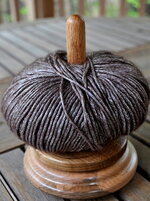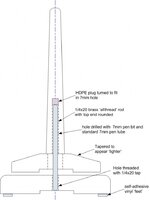monophoto
Member
Here's another project idea for those whose woodturning obsession feeds someone else's obsession with needlework - a yarn caddy.
My wife's knitting club suggested this idea, and stimulated me to do some research on yard caddys. I've now made a prototype - it remains to be seen if they ask me to make any more. Basically, a yarn caddy is a spindle that holds a ball of yard such that the ball can freely rotate as the yarn is pulled off for knitting, crocheting, or whatever. There are three components - a spindle attached to a rotating platform, and a stationary base.
The three parts of the caddy are simple turnings - in my design, the spindle is about 3/4" at the base, and tapers to about 1/2" at the top, and about 6" tall. I made the rotating platform from a scrap of 3/4" thick rift-sawn oak that was 4" square, and the base was made from a scrap of 3/4" maple about 5" square. Note that none of the dimensions are very critical - you can make the caddy whatever size you (and your 'client') want. That said, I do suggest designing the turnings so that the rotating platform is so that it is thinner at the edges - basically, creating the visual illusion that the rotating platform is smaller and lighter than the base.
The only real challenge is making the rotating platform freely rotate. I've seen caddys made using lazy susan bearings - that's a great solution, but one that I opted to not use. Bearings are rated in terms of their diameter and the weight they can carry. One can purchase 3" bearings, but they are rated to carry several hundred pounds - that's overkill because a yarn caddy only needs to carry a few ounces. I couldn't find any locally, and while they can be ordered from various suppliers, they sell for $3-5 each which is more than I wanted to spend.
The approach that I took was to use a pin with a low-friction bearing. The pin is brass and is firmly attached to the base. I wanted to use brass (or stainless steel) to avoid corrosion problems, but the store I visited didn't have rod stock larger than 3/16", so I settled for 1/4-20 brass all-thread instead. I drilled the hole in the spindle portion of the caddy using a standard 7mm pen drill, and glued a spare brass pen tube in the hole so that the all-thread wouldn't rub against wood. Before installing the pin, I mounted it in the chuck on my lathe, and using an ordinary file, I rounded the end to reduce the bearing surface. I also turned a small plug from a scrap of HDPE that I pushed into the hole in the spindle before gluing in the brass tube to create a low-friction bearing surface for the rounded brass tube to rub against.
In retrospect, I think using all-thread actually is better choice than smooth rod for the pin for several reasons. For one thing, the fact that the pin is threaded means that there is no solid surface to rub against the inside of the brass tube - which means less friction. And drilling and tapping the hole in the base to accept the 1/4x20 threaded rod made for a very convenient way to adjust the height of the pin to assure that the space between the rotating platform was enough to prevent it from rubbing on the base, but not so much that it appears to be suspended in air. After adjusting the height of the pin, I turned the base over and put a couple of drops of thin CA in the threaded hole to lock the pin in place.
This is a simple project to do - the turnings are very easy and quick, but it clearly involves a number of steps that would lend themselves to quasi-production methods for those who want to make several to sell at craft fairs. Completed caddys sell through etsy for $30-35.
My wife's knitting club suggested this idea, and stimulated me to do some research on yard caddys. I've now made a prototype - it remains to be seen if they ask me to make any more. Basically, a yarn caddy is a spindle that holds a ball of yard such that the ball can freely rotate as the yarn is pulled off for knitting, crocheting, or whatever. There are three components - a spindle attached to a rotating platform, and a stationary base.
The three parts of the caddy are simple turnings - in my design, the spindle is about 3/4" at the base, and tapers to about 1/2" at the top, and about 6" tall. I made the rotating platform from a scrap of 3/4" thick rift-sawn oak that was 4" square, and the base was made from a scrap of 3/4" maple about 5" square. Note that none of the dimensions are very critical - you can make the caddy whatever size you (and your 'client') want. That said, I do suggest designing the turnings so that the rotating platform is so that it is thinner at the edges - basically, creating the visual illusion that the rotating platform is smaller and lighter than the base.
The only real challenge is making the rotating platform freely rotate. I've seen caddys made using lazy susan bearings - that's a great solution, but one that I opted to not use. Bearings are rated in terms of their diameter and the weight they can carry. One can purchase 3" bearings, but they are rated to carry several hundred pounds - that's overkill because a yarn caddy only needs to carry a few ounces. I couldn't find any locally, and while they can be ordered from various suppliers, they sell for $3-5 each which is more than I wanted to spend.
The approach that I took was to use a pin with a low-friction bearing. The pin is brass and is firmly attached to the base. I wanted to use brass (or stainless steel) to avoid corrosion problems, but the store I visited didn't have rod stock larger than 3/16", so I settled for 1/4-20 brass all-thread instead. I drilled the hole in the spindle portion of the caddy using a standard 7mm pen drill, and glued a spare brass pen tube in the hole so that the all-thread wouldn't rub against wood. Before installing the pin, I mounted it in the chuck on my lathe, and using an ordinary file, I rounded the end to reduce the bearing surface. I also turned a small plug from a scrap of HDPE that I pushed into the hole in the spindle before gluing in the brass tube to create a low-friction bearing surface for the rounded brass tube to rub against.
In retrospect, I think using all-thread actually is better choice than smooth rod for the pin for several reasons. For one thing, the fact that the pin is threaded means that there is no solid surface to rub against the inside of the brass tube - which means less friction. And drilling and tapping the hole in the base to accept the 1/4x20 threaded rod made for a very convenient way to adjust the height of the pin to assure that the space between the rotating platform was enough to prevent it from rubbing on the base, but not so much that it appears to be suspended in air. After adjusting the height of the pin, I turned the base over and put a couple of drops of thin CA in the threaded hole to lock the pin in place.
This is a simple project to do - the turnings are very easy and quick, but it clearly involves a number of steps that would lend themselves to quasi-production methods for those who want to make several to sell at craft fairs. Completed caddys sell through etsy for $30-35.
Attachments
Last edited:


